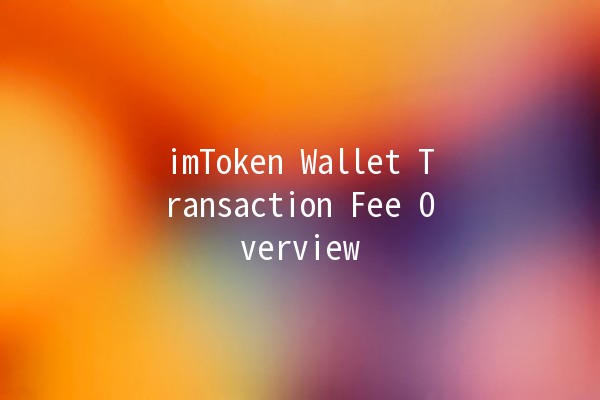In this article, we delve into the details of transaction fees associated with the imToken wallet, a popular choice among cryptocurrency enthusiasts. Understanding these fees is crucial for optimizing your transactions and ensuring you are making the most informed decisions when managing your digital assets.
Transaction fees are costs incurred for processing transactions on a blockchain network. When you send or receive cryptocurrency, miners (or validators, in the case of proofofstake networks) charge fees for including those transactions in the next block. In the context of imToken, these fees apply when you use the wallet to execute transactions.

In essence, transaction fees:
Facilitate Blockchain Operations: Keep the network running smoothly.
Provide Incentives for Miners/Validators: Encourage them to process transactions.
Can Vary Based on Network Conditions: Change according to supply and demand.
To better comprehend how transaction fees work in imToken, let’s explore some specific scenarios:
When you send tokens using imToken, transaction fees will depend on the underlying blockchain. For example:
Ethereum (ETH): The fee will be based on the gas price you set.
TRON (TRX): Transaction fees on the TRON network are typically minimal, which may attract more users.
Typically, there are no fees for receiving tokens. The sender usually bears the transaction cost. However, be aware that the sender’s network fees may impact transaction confirmation times.
imToken offers a feature to swap tokens within the wallet itself. In this case, transaction fees might apply based on the liquidity of the tokens being swapped and the specific blockchain fees.
For instance, if you want to send 1 ETH from your imToken wallet and you set the gas price at 50 Gwei, the transaction fee might be calculated as:
\[ \text{Transaction Fee} = \text{Gas Limit} \times \text{Gas Price} \]
If the gas limit for an ETH transaction is approximately 21,000 units:
\[ 21,000 \, \text{(Gas Limit)} \times 50 \, \text{(Gwei)} = 1,050,000 \, \text{Gwei} = 0.00105 \, \text{ETH} \]
This example helps illustrate how transaction fees can impact the amount you send.
Example: Try sending transactions late at night or during weekends.
Example: If the suggested gas price is high, consider lowering it.
Example: Instead of sending multiple small payments, send one larger payment.
Example: If you are transacting on Ethereum, explore using Layer 2 networks like Polygon.
Example: Some platforms may waive fees for specific periods or for certain token types.
If you do not include a transaction fee or set an extremely low fee, your transaction might not be processed by miners. It could remain pending indefinitely or be dropped from the network.
You can monitor transaction fees within the imToken interface. The app clearly displays the estimated fees before you confirm a transaction.
No, imToken does not charge fees for simply holding or storing your tokens within the wallet. However, you should remain aware of any fees associated with the blockchain itself.
Once a transaction is sent to the network with a fee, it cannot be canceled directly through imToken. However, if the transaction is stuck due to a low fee, you might attempt to speed it up by resending it with a higher fee.
imToken operates without additional fees for sending or receiving tokens. Users only need to pay the network fees.
If a transaction is taking longer than expected, check the gas price set and see if it’s appropriate for the current network conditions. You may need to use the “speed up” function available within some wallets to resend the transaction with a higher gas fee.
Understanding the transaction fees associated with your imToken wallet can significantly enhance your user experience and financial efficiency. By familiarizing yourself with these fees and their influencing factors, utilizing practical tips to reduce costs, and engaging with common inquiries, you can navigate the crypto landscape more effectively. Always keep your finger on the pulse of network conditions and remain vigilant for opportunities to save on fees!
This structure provides a comprehensive overview of transaction fees in the imToken wallet while offering practical tips and addressing common questions, ensuring clarity and usability for readers interested in optimizing their transactions.